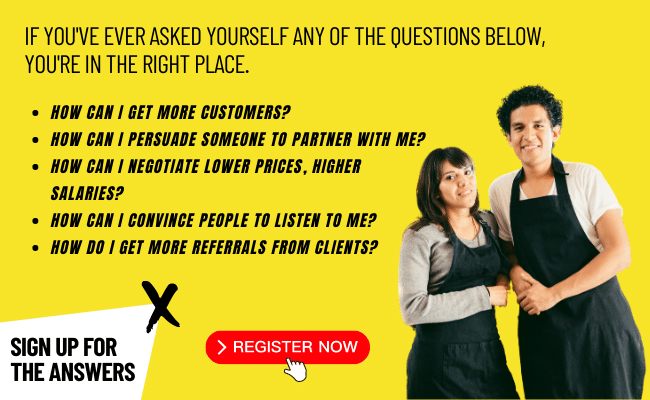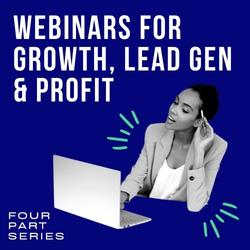Updated: April 27, 2022
How To Write An About Me Page Or Social Media Bio That Gets Attention And Increases Sales For Coaches and Solopreneurs
Table of Contents
People buy from other people or brands they know and trust. What is often a dull and boring About Me page plays a huge role in fostering those feelings. But, make no mistake, it’s also a sales opportunity.
One of the first important things to consider when writing an about me page is that it’s not actually about you.
Your customer isn’t interested in who you are… yet. That potential customer is interested in themselves and their problems. After all, they have problems, and they’re hoping you have solutions.
Your customer is asking questions like “can I trust this person?” “Do I connect with this person?” “Can he/she solve my problem?”
When you realize that your about me page is not actually about you but about your customer, it becomes possible to use your about me page to answer their questions.
There are five all important factors you must include on your about page to convert casual viewers into followers and followers into customers or clients.
5 Must-Have Elements Of A Strong About Me Page
Who you are and why you’re qualified.
This element accomplishes two things. It introduces you and makes a case for why you’re qualified to solve your customer’s problem.
Your introduction should be short and sweet and should match your personality or brand identity.
If your brand is more formal and professional, you may introduce yourself with “Hello, I’m Kevin Smyth, founder of ABC business.”
Of course, if your brand identity is more playful, you may instead go with, “Well hello there! I’m Kevin Smyth and I run things around here.”
Just remember that how you introduce yourself sets the tone of the overall customer experience. It helps them know what to expect as they interact with your, your product and your staff.
Your qualifications should be brief, with no more than two sentences. Be honest about your experience and achievements, but make sure they relate to your customer’s problem.
For example, if your customer is looking for an online course about how to self-publish their novel, your time spent as editor of your high school newspaper isn’t relevant. Instead, you should be sharing things like the number of books you’ve published, your Amazon ranking, and notable publications you’ve written for over the last couple of years.
How you are personally connected to the product.
This is an opportunity to show your customer that you understand their problem.
In this section of your about me page, you want to do three things:
Describe the problem you were seeing or experiencing.
Start by thinking back to before you created your product or solution. What were some frustrations or struggles you or others were experiencing?
This is where you show your potential new customers that you can relate and understand what they’re going through. If you can do a good job articulating your customer’s problem, they’re going to keep reading.
Talk about what led to your decision to make the solution.
Share what inspired you to do something about the problem you were seeing or personally experiencing.
Was it a personal experience with a family member, a deep-seated childhood fear or trauma, or a TED talk? Talk about what made you decide you had to do something.
Share your vision for how your solution will help people.
Paint a picture of how you hope life will be different or better for your customer after they buy your product.
This is a great opportunity to show that you care about and are focused on solving your customer’s problem.
The goal of this section is to convince your customer that you have a deep understanding of their problem and to help them see themselves in your story. If you can envision your product solving their problem, they can envision it too.
Something interesting or unique about yourself.
The third section covers things that are interesting or unique about you, but it’s still about your customer.
When we let people into our world and show them our quirks, hobbies, passions, or pastimes, we’re giving people ways to connect with us on a deeper level. Inevitably, this strengthens that know and trust factor that’s so important when it comes to making sales.
This section doesn’t have to be long. In truth, a few well-written but honest sentences are enough.
I’m not suggesting you disclose anything serious or traumatic – most of those reading this should be potential buyers, so keep it relatable.
Maybe in your spare time you enjoy playing music, running, and camping.
And maybe your favorite pastimes are things like tubing, enjoying the night sky, and learning to country line dance.
That kind of stuff. I would never suggest you lie to your customers, but I strongly recommend you leave out anything highly controversial unless it’s on point with your brand.
Hopefully, most of your potential customers will find they have something in common with you (who doesn’t like music?) and in doing so they’ll feel more connected and willing to trust you.

Get and use professional, relevant photos.
We’re all familiar with the saying, a picture is worth a thousand words, but when it comes to how your customers connect with you, your picture really can communicate volumes.
When we see a friendly human face, we feel more at ease, more curious, and more receptive to what that person has to say.
With that in mind, make sure you follow these two tips when getting an About Me photo:
Get professional photos even if your brand is more laid back and playful, professional photos communicate that you take your role in solving your customer’s problem seriously.
Match your branding or personality just like a greeting, this is an opportunity to set the tone for all future customer interactions.
However you present yourself, be sure to choose a pose that makes you seem friendly and inviting, both qualities are an asset to any brand.
If you’d like to learn more about using professional and relevant photography for your coaching, membership or personality-driven brand, click here.
Email sign-up or social media links to stay connected.
While you ultimately hope they stick around on your website and buy something from you, you do want a way to stay connected with a potential customer who may not be ready to buy just yet.
There are two ways I recommend helping a potential customer stay connected.
An email sign-up is by far the best way to develop a relationship with your customer that will allow you to sell to them time and time again. Email marketing is not only still going strong, but it’s still one of the best and most reliable ways of growing sales and leads consistently.
On your sign-up form, let your customer know what they can expect from your email newsletter.
- What kind of value do you provide?
- How often, and when, do you send emails?
- Are there any gifts or incentives you offer for new sign-ups?
Including this info will go a long way in getting people to sign up.
If you don’t have an email list or are not ready to start one, you can also point people to social media. Make sure you offer two social network options, as people feel most comfortable connecting on platforms they already use. Not everyone uses Facebook so be sure to include Twitter, YouTube, Instagram or TikTok.
I recommend two options, so you’re not spreading yourself too thin trying to stay up with four or five platforms, but enough to give your audience a choice. And be sure to provide a description of the kind of content people can expect from you like, “YouTube – weekly video reviews of the latest advancements,” or “Twitter – tweet-storms featuring my top-tier motivation to keep you going strong.”
While this strategy may not get you immediate sales, it’s a great long-game strategy. You’re fostering connections with customers who will one day be excited to buy and talk about your product.
Now that we’ve covered the important five elements of your new About Me page (or social media bio) it’s time to get into the marketing side, after all, if you’re in business, you’re also in marketing.
The About Me is one of the most important pages on the website of any marketer. The five elements we discussed above are fully integrated, but with a marketing angle from a marketing perspective.
About Me Page From A Marketing Perspective
From a digital marketing perspective, the About Me page or Social Media Bio still uses the same outline but with a heavier marketing tone divided into five elements:
- The Hook
- The Benefits
- The Proof
- The Personal Story
- The Opt-In or CTA
#1: The Hook
You are your brand. Your name and personality are the foundation of your business model.
As such, you need an amazing hook to capture a person’s attention immediately. You want to get that reader intrigued, so they keep reading down the page. It’s also important that you prove you can relate to your audience, and this is where a well-formed hook really shines.
There are three methods most marketers use as their hook; questions, a story or the open loop.
Ask Questions
One of the easiest ways to hook your reader while proving your relatability is by asking questions. Do you often feel _____ after you _____? Are you somebody who _____ when you _____” You want to show that you understand the pain points your audience experiences because you once had similar pain or setbacks in life. And you need to make this potent in a single sentence. This is what will drive every visitor to keep reading your page and to go to the next part.
Below is an example of a hook-filled webinar registration call-to-action we created for a ServerWise client for use on their About Me page. The box worked, and webinar registrations from the about page increased nearly 40%.

Tell A Story
On your About Me page on your website, you’re going to start out with the pain point hook question, and that should lead into an interesting story. People love stories, particularly ones that they can relate to while giving them hope or insight. This story, your story, is also an effective way of pulling them into your world and telling them just how much value they’ll get in your lives by using your services or products.
Use a story to describe the problems and pains your own viewers or readers experience in their lives, and share with them how you overcame or handled similar issues. Essentially, you want your visitor to see how your story and their own personal story and experiences match up and intersect.
"If you can define the problem better than your target customer they're gonna assume that you have the solution."
Jay Abraham

Create An Open Loop
As human beings, we crave (and expect) answers. Nothing infuriates a person more in terms of a story when it just simply ends without explanation or a quick wrap-up (I’m still annoyed at The Sopranos finale). This facet of the human condition is handy for marketers because it lets you tap into that desire to close doors when they’re left open.
Essentially, you’re looking to build curiosity and intrigue your audience. As their curiosity meter goes up, so does their desire to stick around and find out the end or solution.
A quick example of an open loop is:
I've discovered an astonishing way to do A, B and C. Before I give you all the information, so you can do it yourself I want to make sure you keep reading because I don't want you to miss out on anything. It's that good."
#2: The Benefits
Don’t confuse the benefits with the features. You’re not going to list the stunning and eye-catching features your product or service offers. Instead, we’re focusing on the real benefits a person will get by sticking around and reading the rest of your About Me page.
After all, this isn’t directly about your coaching or membership site, product or enhanced service. This is about driving the site visitor to consume as much information about you as possible until he or she trusts you enough to complete a preferred action. This is how you increase registrations, subscribers and even sales.
Focus on the transformation.
- What do you or your brand add to a customer’s life?
- How does it actually benefit them?
- What is the transformative outcome they can expect and anticipate?
- What exactly will a person get by sticking around today or even tomorrow?
#3: The Proof
Social, sales or media proof is crucial. This is the area of your About Me page or social bio where you provide evidentiary support of your claims above.
You want to display yourself through accolades, media mentions, video and written testimonials and even screenshots of comments made by users or customers from Twitter and Facebook.
Modesty doesn’t work in this section, so set the humility aside and show your site visitors that you are what you say you are and have done what you claimed.
#4: The Personal Story
You may have already told a short story as part of your hook, but here is where you get personal. Dig deep and really connect with the reader by sharing your story of exactly how you came to do what you do.
Money troubles? Stress and anxiety? Mental health issues? Family problems?
You’re not just humanizing yourself, you’re helping to form a personal and emotional connection with your site visitor.
Let yourself be open and genuine, and people will identity with you and come to trust you much faster.

#5: The Opt-In Form or Call-To-Action
Here’s the tactical section of your About Me page. This area is what the entirety of your page has built up to, so it’s critical that you include it.
You’ve taken your site visitors on a journey where they’ve read your hook, learned a bit about you (story) and what you can do for them (benefits) and finally they got to know you even better (personal story) and they like and trust you. What now?
Now you take this newfound trust that you’ve earned, and you direct them to a sign-up form for your email marketing list.
I recommend you state very plainly how often you email and what type of content you will be sharing. Make it worth their time and email address and consider including a strong lead magnet (action guide, checklist, exclusive video, etc.).
You’ll get higher subscriber numbers with a more detailed offering, so each person knows exactly what to expect from you in exchange for their personal information.
Closing Thoughts
As you’ve no doubt noticed, this article is primarily geared toward solopreneurs, coaches, consultants, trainers and all around individual experts. In other words, when a brand identity is also an individual.
You are your brand, and that means the About Me page is critical to your success and reputation. As you build your brand, you elevate your image, so put as much time and effort into crafting the perfect About Me page for your business because it will pay dividends for years to come.



Leave it to brands like Canva, Wendy’s and Slack to turn the once-dreaded 404 error page into a play space. Introducing the gamification of the error page and people are loving it. Keep Learning >

Imagine a magical platform where you can share your first video with zero followers and suddenly have millions of views. Sounds unbelievable, doesn’t it? That is the current power of TikTok and many small and local businesses have experienced the sudden impact of a viral post on the young platform. Keep Learning >



